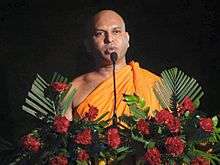Maha Bodhi Society
| Part of a series on |
| Buddhism |
|---|
 |
|
The Maha Bodhi Society is a South Asian Buddhist society founded by the Sri Lankan Buddhist leader Anagarika Dharmapala and the British journalist and poet Sir Edwin Arnold. The organization's self-stated initial efforts were for the resuscitation of Buddhism in India, and restoring the ancient Buddhist shrines at Bodh Gaya, Sarnath and Kushinara.[1][2][3]
Although some Indians had remained culturally Buddhist for centuries after the decline of Buddhist philosophy, they did not self-identify as "Buddhist". The Maha Bodhi Society renewed interest in Buddhism, and spawned the Ladakh Buddhist Association, All Assam Buddhist Association, and Himalayan Buddhist Society, as well as laying the grounds for the Dalit Buddhist movement.[4]

Origins
In 1891, while on pilgrimage to the recently restored Mahabodhi Temple at Bodh Gaya, the location where Siddhartha Gautama (the Buddha) attained enlightenment, Anagarika Dharmapala had experienced a shock to find the temple in the hands of a Saivite priest, the Buddha image transformed into a Hindu icon and Buddhists barred from worship as a result of which he began an agitation movement.[5] Prior to that, in 1885 Sir Edwin Arnold visited the site and published several articles drawing the attention of the Buddhists to the deplorable conditions of Buddhagaya.[1][2][3] The Buddhist renaissance inaugurated by Anagarika Dharmapala through his Mahabodhi Movement has also been described as "conservative" for it considered Muslim conquest in the Indian subcontinent responsible for the decay of Buddhism in India, in the then current mood of Hindu-Buddhist brotherhood.[6]
The Mahabodhi Society at Colombo was founded in 1891 but its offices were moved to Calcutta the following year. One of its primary aims was the restoration of the Mahabodhi Temple at Bodh Gaya, the chief of the four ancient Holy sites to Buddhist control.[7][8] To accomplish this Dharmapala initiated a lawsuit against the Brahmin priests who had held control of the site for centuries.[7][8] After a protracted struggle this was successful with the partial restoration of the site to the management of the Maha Bodhi Society in 1949.[7][8]
Maha Bodhi Society branches have been established in several countries, most significantly in India and Sri Lanka. A United States branch was founded by Dr. Paul Carus. There is also a Maha Bodhi Society of Bangalore, founded by Acharya Buddharakkhita in 1956, which is not a part of or tied to the Maha Bodhi Society of India or Sri Lanka.
The Mahabodhi Temple

After the defeat of the Palas by the Hindu Sena dynasty, Buddhism's position again began to erode and was soon followed by the conquest of Magadha by General Ikhtiar Uddin Muhammad Bin Bakhtiyar Khilji.[9] During this period, the Mahabodhi Temple fell into disrepair and was largely abandoned. During the 16th century, a Hindu monastery was established near Bodh Gaya. Over the following centuries, the monastery's abbot or mahant became the area's primary landholder and claimed ownership of the Mahabodhi Temple grounds.
In the 1880s, the-then British government of India began to restore Mahabodhi Temple under the direction of Sir Alexander Cunningham. In 1885, Sir Edwin Arnold visited the site and published several articles drawing the attention of the Buddhists to the deplorable conditions of Buddhagaya.[1] He was guided in this undertaking by Ven.Weligama Sri Sumangala[2][3] In 1891, Anagarika Dharmapala started a campaign to return control of the temple to Buddhists, over the objections of the mahant. The campaign was partially successful in 1949, when control passed from the Hindu mahant to the state government of Bihar, which established a temple management committee. The committee has nine members, a majority of whom, including the chairman, must by law be Hindus. Mahabodhi's first head monk under the management committee was Anagarika Munindra, a Bengali man who had been an active member of the Maha Bodhi Society.
Sarnath
In 1931 the Mulaghandakuti Vihara was erected at Sarnath, an ancient Buddhist site.[8]

Publications
The Maha Bodhi Society has a robust tradition of publications, spanning from Pali translations into modern Indian vernacular languages (such as Hindi) to scholarly texts and new editions of Pali works typeset in Devanagari to appeal to a Hindi-educated Indian audience. They have also published books and pamphlets in local/regional languages and dialects, sometimes in partnership with other presses.
Leadership

The present General Secretary of the Maha Bodhi Society of India is Venerable Pelwatte Seewalee Thero, present President is Prasanna Jayasuriya, the great grandson of Anagarika Dhammapala, Joint Secretaries Venerable Kahatagollawe Medhankara Thero and M. Suddhamma Thero.
At a meeting in September 2008, the Maha Bodhi Society passed a rule that only persons born into Buddhist families will be eligible to serve as president or as one of the vice-presidents of the Society. The outgoing president, B. K. Modi, was a Hindu; he assumed the position of patron. At the same meeting, the 14th Dalai Lama was given the new title of chief patron.[10]
See also
References
- 1 2 3 Maha Bodhi Society
- 1 2 3 Arnold, Edwin (1906). India Revisited, London: K. Paul, Trench, Trübner
- 1 2 3 Dipak K. Barua (1981). “Buddha Gaya Temple: its history”, Buddha Gaya: Buddha Gaya Temple Management Committee
- ↑ D.C. Ahir. Buddhism in Modern India. Delhi: Sri Satguru Publications, 1991. p. 17.
- ↑ Sean O'Reilly, James O'Reilly, Pilgrimage: Adventures of the Spirit, Travelers' Tales, 2000,ISBN 1-885211-56-2 pg 81-82
- ↑ A Close View of Encounter between British Burma and British Bengal
- 1 2 3 Arnold Wright, Twentieth Century Impressions of Ceylon: its history, people, commerce, industries, and resources, "Angarika Dharmapala", Asian Educational Services, 1999, ISBN 81-206-1335-X pg.119
- 1 2 3 4 C. J. Bleeker, G. Widengren, Historia Religionum, Volume 2 Religions of the Present: Handbook for the History of Religions, Brill Academic Publishers, 1971, ISBN 90-04-02598-7 pg. 453
- ↑ The Maha-Bodhi By Maha Bodhi Society, Calcutta (page 205).
- ↑ Sengupta, Ratnottama (September 28, 2008).Now, Hindus can't head Mahabodhi Society Times of India